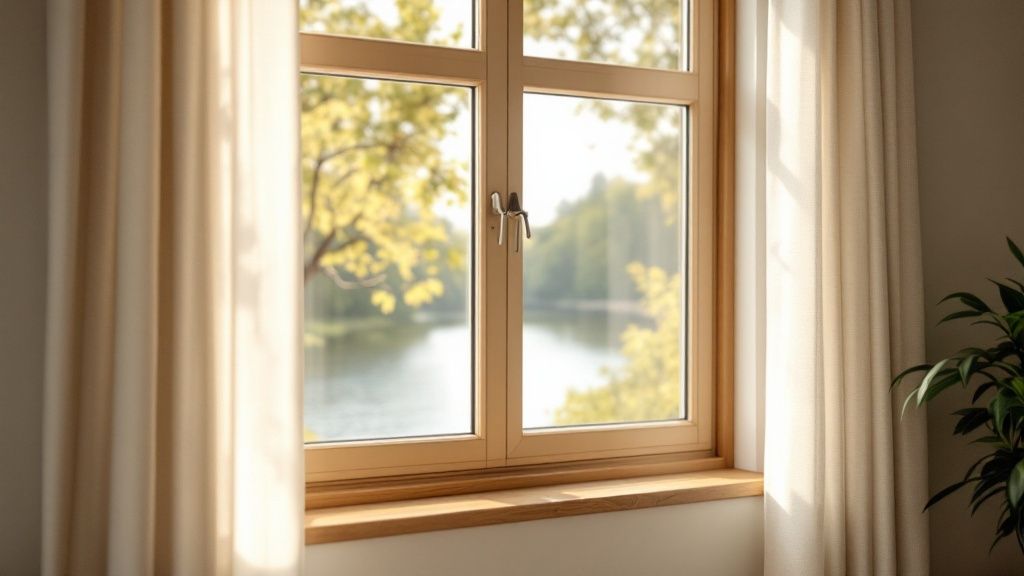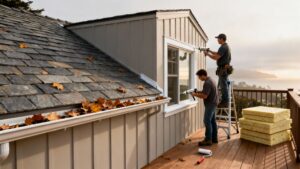A double hung window is a classic style defined by two vertically sliding sashes. This means both the top and bottom sections can open on their own, giving you great control over airflow. It's one of the most popular window choices for homes across the Bay Area.
Unpacking the Classic Double Hung Window
When you talk to contractors and architects in Berkeley or Oakland, the double hung window is almost always part of the conversation. Its lasting popularity comes from a simple design that combines timeless looks with practical use. The key difference from a single hung window is that both sashes move, not just the bottom one.
This dual movement is what makes it so special. It creates a natural airflow perfect for ventilation. By lowering the top sash, you let warm air near the ceiling escape. At the same time, raising the bottom sash pulls in fresh, cool air.

Key Components at a Glance
To really understand a double hung window, it helps to know the parts. Each piece has a specific job that affects how the window works, how secure it is, and how it looks. Think of it as a quick anatomy lesson for any builder or homeowner in the Bay Area.
Let's break down the essential parts.
Anatomy of a Double Hung Window
This table covers the main parts you'll find on nearly any double hung window. This makes it easier to understand its purpose.
| Component | Function |
|---|---|
| Upper & Lower Sash | These are the two movable frames that hold the glass panes. |
| Window Frame | The outer structure that holds the sashes and allows them to slide. |
| Sash Locks | Found where the sashes meet, these lock the window securely when closed. |
| Balance System | An internal spring or cord mechanism that makes the sashes easy to open and close. |
| Tilt Latches | A great feature on modern windows that lets sashes tilt inward for easy cleaning. |
Knowing these parts makes it easier to discuss window options with a "lumberyard near Oakland" or troubleshoot issues.
From Classic Charm to Modern Performance
The double hung window is more than just a popular choice; it's a piece of living history that has been improved over centuries. Its story starts in the late 17th-century in England. It later became a key feature of American colonial architecture.
Early designs were all wood with small glass panes. You can learn more about this journey over at crystalglass.ca.
As glass manufacturing improved, so did the windows. Larger panes became common, and the double hung style adapted. You can see this history in Bay Area homes, from San Francisco Victorians to Berkeley Craftsman houses.

The Shift From Past to Present
While the basic design has stayed the same, the technology behind it has improved a lot. This is why the classic style is still a top pick for modern building projects. The biggest changes have been in materials and mechanics.
Early double hung windows used ropes, pulleys, and heavy counterweights hidden in the frame. Today, they use modern balance systems with springs, making the sashes glide easily.
Material and Performance Innovations
The materials used for double hung windows have also changed, improving their durability and energy efficiency. This is especially important for meeting California's strict building codes.
- From Wood to Advanced Composites: Wood is a beautiful choice for historic homes. But modern materials like vinyl and fiberglass offer better durability against Bay Area weather. They resist moisture and warping with less maintenance.
- Enhanced Energy Efficiency: Old single-pane glass offered poor insulation. Today’s windows use insulated glass units (IGUs) with options like Low-E coatings and argon gas fills. According to the California Energy Commission, these features significantly reduce heat transfer, lowering utility bills.
- User-Friendly Features: Modern designs are much easier to live with. Tilt-in sashes let you clean the exterior glass from inside your home. This is a huge benefit for multi-story properties common in the Bay Area.
This evolution means choosing a double hung window today gives you a classic look with modern engineering. You get comfort, efficiency, and ease of use for any project.
Why Bay Area Homes Need Double Hung Windows
Choosing the right window is about more than looks. It's about finding a solution that works for the local environment. For builders and homeowners in the Bay Area, double hung windows are a smart investment that blends style and performance.

From foggy San Francisco mornings to sunny East Bay afternoons, these windows offer real advantages. Let's look at the benefits that make them a great addition to Bay Area properties.
Superior Ventilation for Bay Area Breezes
The Bay Area's mild climate is perfect for double hung windows. Unlike other styles, they let you open both the top and bottom sashes at once. This creates a natural cooling effect.
By lowering the top sash, warm air near the ceiling flows out. Raising the bottom sash pulls in cooler, fresh air. This is an efficient way to cool a home without using AC, a big plus for energy-conscious projects.
Unmatched Ease of Cleaning
Cleaning windows on a multi-story home in Berkeley or Oakland can be a hassle. Modern double hung windows solve this problem with tilt-in sashes. This feature lets you pivot both sashes inward.
This simple design means you can clean the exterior glass safely from inside. No more wobbly ladders or hiring professional cleaners. It's a major time and money saver.
This feature is a key selling point for homeowners and property managers.
Enhanced Safety and Security
Safety is a top priority, especially for families with children. Double hung windows offer a great security advantage. You can lock the bottom sash while opening the top sash for ventilation.
This allows fresh air to circulate without creating an accessible opening at a low level. It’s a simple way to keep a room comfortable and secure. This makes them a great choice for bedrooms and ground-floor rooms.
Double Hung vs. Single Hung and Casement Windows
When working on a project in the Bay Area, choosing the right window involves balancing looks, performance, and function. We often get asked how double hung windows compare to other styles. The best fit depends on the room and the home's design.
Knowing the differences is key. A single hung window looks similar, but only the bottom sash moves. Casement windows are different—they swing outward on side hinges like a door.
Head-to-Head: The Three Main Styles
Let's compare these three popular styles. From airflow in a Berkeley craftsman to cleaning in an Oakland remodel, each has pros and cons. The practical differences often guide the final decision.
For a deeper look, check out our guide on the key considerations when choosing windows and doors.
Window Style Showdown: Double Hung vs. Single Hung vs. Casement
We've broken down the details into a simple comparison table. This can help you see which window works best for your project.
| Feature | Double Hung Window | Single Hung Window | Casement Window |
|---|---|---|---|
| Airflow Control | Excellent. Opening both sashes creates natural convection that pulls cool air in and pushes warm air out. | Good. Ventilation is limited to the bottom sash, which is effective but less versatile. | Excellent. The entire sash swings open to catch breezes and direct them into the room. |
| Ease of Cleaning | Excellent. Tilt-in sashes let you clean both sides of the glass from inside the house. | Fair. Cleaning the exterior of the fixed top sash often requires a ladder. | Good. You can clean them from the inside, but reaching around the open sash can be awkward. |
| Energy Efficiency | Very Good. Modern seals and locking mechanisms create a very tight fit. | Very Good. Fewer moving parts can sometimes mean a slightly tighter seal over time. | Excellent. When closed, the sash presses firmly against the frame, creating an incredibly airtight seal. |
| Security | Good. You can open the top sash for fresh air while keeping the bottom one securely locked. | Good. A single, reliable lock on the bottom sash keeps the window secure. | Very Good. Their hook-shaped locks embed into the frame, making them very hard to pry open. |
| Cost | Moderate. The added mechanism for the second moving sash makes them pricier than single hung windows. | Budget-Friendly. Their simple design makes them the most affordable of the three. | Higher Cost. The complex crank hardware makes these a more expensive choice. |
The chart shows the balanced benefits of double hung windows, especially for airflow and maintenance.

While casement windows might be slightly more energy-efficient, the double hung window offers a fantastic blend of features perfect for everyday life in the Bay Area.
Unpacking Modern Energy Efficiency
Today’s double hung windows are far more advanced than older single-pane versions. They are engineered to lower your energy bills and make your home more comfortable. Understanding this technology is key to meeting California's energy standards.
The journey to modern, efficient windows is a story of innovation. It began in the 1950s with insulated glass units (IGUs). You can learn more about the history of window innovations to see how far we've come.
The Core of Energy Savings
The key to a modern double hung window is its Insulated Glass Unit (IGU). It is a sealed "sandwich" where each layer has a job.
- Dual-Pane Glass: Two panes of glass are separated by a spacer. This gap is the first line of defense against heat transfer.
- Low-E Coatings: A thin, invisible metallic layer called a Low-Emissivity (Low-E) coating is applied to the glass. It reflects heat back to its source, keeping your home warmer in winter and cooler in summer.
- Argon Gas Fill: The space between the panes is often filled with a dense gas like argon. Argon is a better insulator than air, slowing heat movement and improving efficiency.
According to Energy Star, homeowners can save an average of 12% on their energy bills by replacing single-pane windows with Energy Star certified models. This shows how much modern features matter for any Bay Area project.
Frame Materials That Boost Performance
The window frame also plays a huge role in efficiency. While wood frames are classic, modern materials offer better insulation and durability.
Materials like fiberglass and vinyl are excellent insulators. They also resist rot, warping, and moisture, ensuring a tight seal for years. This is crucial for homes in the varied climates around the Bay Area.
For more details, our guide on choosing energy-efficient windows is a great resource.
How to Choose the Right Double Hung Windows
Choosing the right double hung windows for your Bay Area project means balancing performance, style, and budget. The first step is selecting the frame material.
Each material has strengths suited to Bay Area microclimates.
- Wood: Offers a classic look perfect for historic homes in Berkeley or San Francisco. It provides natural insulation but requires more maintenance.
- Vinyl: A low-maintenance and budget-friendly choice. It delivers excellent energy efficiency and stands up to the elements well.
- Fiberglass: Ideal for coastal homes or those with high sun exposure. It is incredibly strong, resists moisture, and won’t warp with temperature changes.
Matching Windows to Your Home
Next, think about the home's architectural style. A double hung window is versatile and can be customized with grille patterns and hardware finishes to fit any home.
Finally, consider the installation. While some may try replacing windows yourself, professional installation guarantees a perfect fit. This is crucial for optimal performance and energy efficiency.
Frequently Asked Questions About Double Hung Windows
Here are answers to common questions we hear from Bay Area builders, contractors, and homeowners.
1. Are double hung windows more expensive than single hung?
Yes, double hung windows typically have a higher upfront cost than single hung windows. This is because the mechanism for the second moving sash adds complexity and materials to the design. However, many find the investment worthwhile for the superior ventilation and ease of cleaning.
2. How long do double hung windows last?
The lifespan depends on the frame material and installation quality. High-quality vinyl windows can last 20-40 years, while fiberglass can last 50 years or more. Wood windows can last a lifetime with proper maintenance, such as regular painting or sealing to protect against moisture.
3. Do double hung windows leak more air?
This is a common myth based on old, worn-out windows. Modern double hung windows are engineered with high-quality weatherstripping and robust locking systems to create a tight seal. When installed correctly, they are highly effective at preventing air leakage and meet strict energy codes.
4. Are double hung windows secure for Bay Area homes?
Absolutely. Double hung windows are a secure choice, featuring strong locks where the two sashes meet. A key security benefit is the ability to open the top sash for ventilation while keeping the bottom sash locked, which is ideal for ground-floor rooms in Berkeley or Oakland.
5. How do I maintain my double hung windows?
Maintenance is straightforward. Regular cleaning of the glass and tracks is most important to ensure smooth operation. You can find tips on cleaning double pane windows flawlessly. If it’s time for an upgrade, we offer resources for Bay Area window replacement.
For expert advice on choosing the perfect "Bay Area windows and doors," visit our Berkeley showroom. The team at Truitt & White is here to help you find the right solutions for your project. Connect with us today!









